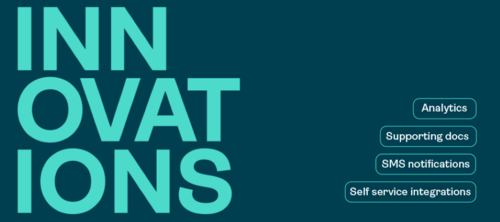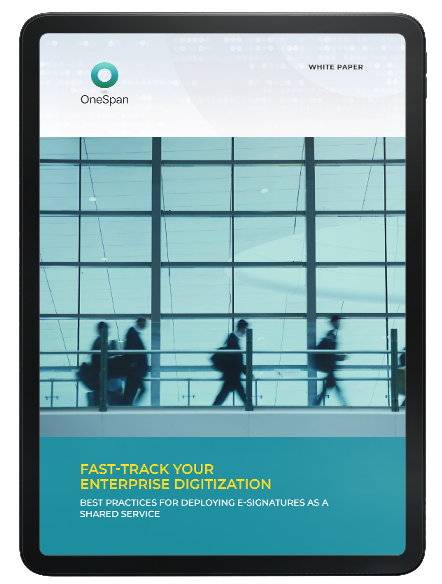SC Ventures deploys eSignature across Standard Chartered, in 21 countries and counting

The need for electronic signature across industries, use cases, and geographies has been amplified by the rapid shift in customer needs to remote interactions and transactions. In the banking industry , electronic signatures provide customers a convenient and secure way to sign financial services agreements without having to travel to the branch. E-Signatures also streamline internal processes and provide efficiency gains through automation, which is driving demand for the technology in HR departments, contracting and procurement, legal and compliance teams, and more.
As financial institutions and other organizations continue to invest in efforts to improve the employee and customer experience, enterprise-wide digitization initiatives have risen in priority. For digital capabilities that impact the entire organization – such as e-signature – many organizations are prioritizing a shared services approach over siloed implementations.
Standard Chartered, one of the world’s top 100 banks, led the way in centralizing its e-signature capability in a group-wide rollout. Its 90,000 employees serve customers around the world, from Hong Kong to the US. Within the bank, the innovation arm SC Ventures partnered with OneSpan to realise the bank’s e-signature tool: SC eSign. SC Ventures is a business unit that provides a platform and catalyst for the bank to promote innovation, invest in disruptive financial technology, and enable alternative business models driven by fintech.
SC eSign has revolutionized the digital signing experience at the bank. Standard Chartered is now processing 40 use cases, including mortgage, client onboarding, wealth management services, vendor contracts, HR agreements, and other banking services . SC eSign is live with electronic signature in 21 countries and secured regulatory approval for use in 28 jurisdictions.
Driven by the pandemic, the bank’s e-signature initiative was rolled out with speed and scale. To provide insight into their best practices approach, Thorsten Neumann, CTO at SC Ventures, joined me for a presentation at the Singapore Fintech Festival to share the latest news about their e-signature project. You can watch the full presentation on-demand.
Moderator: What is the biggest challenge to greater adoption of e-signatures in banking?
Neumann: I think a big challenge is organizational transformation. There is often difficulty understanding how esignatures fit into business processes versus it being an issue on the technology side. The technology has been around for years. The difficulty is more about understanding how business processes need to adapt to new online journeys. New questions arise with the shift to digital. For example, how do we verify these signatures are real? How do we confirm that the counterparty who signed the document was authorized to sign it? Also, each implementation is unique and requires understanding of the legal and compliance requirements of the respective jurisdiction.
What needs to be in place to be successful with e-signature?
Hajarnis: Establishing a framework that combines technology, people, and business processes is key for digital transformation efforts like e-signature. Building out the tech stack makes it easier for every line of business to adopt. There’s no reinventing the wheel for each implementation. But it's not just about the new technology or functionality. You also need to work with your legal and compliance team in terms of the governance required by geographies, the business, and regulations. Mortgages have different regulatory needs compared to wealth management, for example.
Neumann: It’s also important to view e-signatures as an organization-wide platform, as opposed to a certain number of business units or someone in a silo adopting an e-signature platform. That means: scalable, centralized, a shared service. The difference in this scenario compared to other general technology infrastructures being internally run by organizations is that this is client-facing. It represents the bank, so branding and a consistent client experience needs to be a shared focus.
What are some e-signature use cases for the future?
Neumann: Our successes have been well understood use cases. For instance, mortgage repricing. It is a very common activity with a high volume of transactions, so it made perfect sense to adopt e-signatures. However, once a certain market sets a precedent for a certain type of transaction, we can easily scale into more markets so the whole business can benefit.
There is also the question of how to do the identification and verification of the individual beyond just the signature. Who is the signer and how do they attest that? Is it through 2FA or an integration into a national identification system? Perhaps that extends to video experiences where I can actually see the client or the counterparty while signing the transaction.
What are some upcoming innovations for e-signature?
Hajarnis: I see two pressures driving innovation. One is that consumers want a human element in their digital experience. If you look at the spectrum of transactions being digitized, some are fairly simple. Then, there are more complex transactions like mortgage refinancing, loan restructuring, advisory services, and account maintenance. Complex transactions require mediation or assistance by an advisor or banker. That’s how we came to launch OneSpan Virtual Room, which brings together audio and video with assisted screen sharing. Imagine I'm a banker working on a mortgage for customers at home, and they have a question. It’s reasonable they would have questions before they sign. How we solve that is simple. The customer messages me and I get on a quick screen-sharing session. I can authenticate the identity of the person coming into that online session using two-factor authentication (2FA) or a government-issued ID, or another authentication method such as biometrics. Once the customer successfully proves their identity, they are in the virtual signing room where we look at the documents together, answer their questions, sign, and can even notarize the document.
Learn More About Virtual Room
The second factor driving innovation is the need to adapt to regulations and legislation by geography. I see a lot of countries, especially advanced economies, moving towards a national ID or digital ID model. There's a fair amount of regulation and legislation about what identity verification and authentication needs to happen from a signing perspective.
Neumann: Thanks for highlighting that. We are in markets such as Pakistan, Indonesia, and certain African markets, where e-signatures require a higher level of identity assurance or a higher certificate signing standard than just drawing a mark on a document. In Europe, there are qualified electronic signatures, which are X.509 certificate-based, and that is a very mature ecosystem. As we go into emerging markets, the standards tend to be very high but the broader infrastructure is perhaps still maturing. In markets like Singapore and India, they have a national identification system and we are looking at how to tie the two together.
What that means is, how do we link into those government identification systems and bring in that level of authentication? In India, for example, it’s Aadhaar. To think of the experience in practical terms, visualize somebody receiving a document, wanting to sign it and clicking on a link that brings them to the OneSpan Sign platform. Also, at the same time triggering an Aadhaar verification, which sends a message to the signer’s mobile. It is through the government identification system that the cryptographically-secured transaction between two parties is effectively irrefutable.
In Singapore, we're working with Singpass, which is similar. Every citizen and resident has the Singpass application, and there too, you'd be signing a document and would get a push notification. By confirming that [i.e., entering the one-time code from the push notification into the electronic signing session] as well as a biometric authentication on the phone, we're closing that transaction.
In the markets that we are looking to expand more into, we have those options because of the OneSpan Sign product and our integrations into government ecosystems. That opens up opportunities in China, Taiwan, Pakistan, Bangladesh, and more – which I don't think every other product in the market can do. Actually, not that many products in the market can do.
Closing Thoughts: Digital Transformation in Banking and Deploying Electronic Signature as a Shared Service
As part of their best practices approach to electronic signature, SC Ventures understood the need to establish a governance framework and enterprise shared services approach. That helped them setup and onboard e-signature use cases from many lines of business and departments, without having to start from zero for each new process.
As a leading e-signature provider, we have learned there are many ways to achieve enterprise digitization with an e-signature capability. While all take a similar approach – start small, build success, and iterate – each enterprise is a unique entity with its own set of practices and customer journey. We have extensive experience deploying e-signature as a microservice, and can provide tailored best practices guidance to your organization for a personalized digital transformation strategy.
To learn more about creating a shared services deployment and enabling new business models through digitization and digital technologies, watch the full Q&A with SC Ventures or download this white paper: Fast Track Your Enterprise Digitization: Best Practices for Deploying E-Signatures as a Shared Service.
About SC Ventures FinTech Bridge
SC Ventures FinTech Bridge is our global platform connecting and matching partners such as startups, investors, ecosystem partners and our corporate clients to the Bank’s communities to find solutions to diverse types of problem statements. Standard Chartered offers direct connections at a global scale for collaborations and future partnerships.
About SC Ventures
SC Ventures is a platform and a catalyst for Standard Chartered to promote innovation, invest in disruptive financial technology and explore alternative business models. Focused on “Rewiring the DNA in banking”, SC Ventures leverages on human-centered design, lean start-up approach and fintech enablement, while nurturing an intrapreneurial culture by empowering employees to bring ideas to life. We deliver forward-thinking innovations through an open platform and a network of people and partnerships. https://scventures.io/









